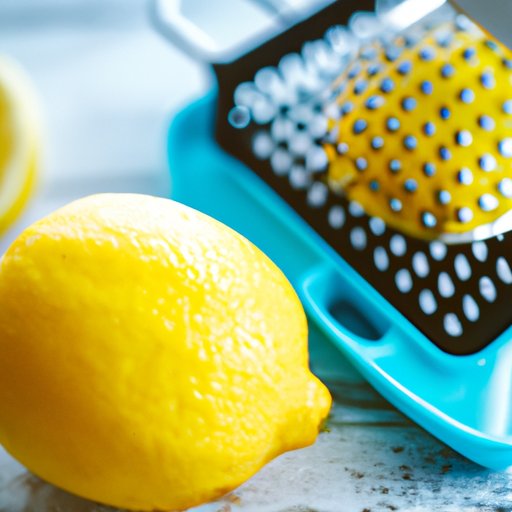
I. Introduction
When it comes to cooking and baking, lemon zest is a secret ingredient that can make all the difference. Zesting a lemon may seem like a small task, but it can have a transformative effect on your dishes. Whether you’re a professional chef or a novice cook, learning how to zest a lemon can help elevate your culinary skills to the next level.
So, if you’re ready to zest up your life, keep reading! In this article, we’ll explore the ins and outs of lemon zesting, including safety tips, step-by-step instructions, and expert techniques for enhancing the flavor and presentation of your dishes.
II. Lemon Zesting 101: The Essential Kitchen Skill You Need to Know
Lemon zest is the colorful outer layer of the fruit’s skin. It’s used to add flavor and aroma to dishes, particularly in baking and cooking. Zesting a lemon removes this thin layer and leaves behind the bitter white pith.
Knowing how to zest a lemon properly will ensure that you get the most flavor out of the fruit while avoiding any unwanted bitterness. Additionally, because the zest contains essential oils, it can be a key ingredient in creating delicious and aromatic dishes.
Before you start zesting, it’s important to note that lemons can be slippery and difficult to handle, so be sure to exercise caution when cutting and peeling. Consider placing a damp towel or cutting board underneath to provide more stability.
III. 5 Simple Steps to Perfectly Zesting a Lemon: A Beginner’s Guide
If you’re new to zesting, fear not! Here’s a step-by-step guide to help you get started:
- Wash the lemon thoroughly with cold water and dry it with a clean towel.
- Place the lemon on a cutting board and slice off the top and bottom ends, leaving a flat surface.
- Using a sharp vegetable peeler or a zester tool, remove the thin outer layer of the skin, being careful not to cut into the white pith.
- Rotate the lemon and continue to peel or zest until you have removed all the yellow from the surface of the fruit.
- Once you have finished zesting, use the lemon juice and zest as directed in your recipe, or store the zest in an airtight container in the fridge for up to a week.
It’s important to note that you should only zest the lemon skin’s outer layer, and avoid removing any of the white pith, which can be bitter. You can also use a microplane or box grater with fine holes if you don’t have a zester tool.

IV. The Secret to Zesting a Lemon Like a Pro: Tips and Tricks Revealed
Now that you know the basics, let’s dive into some insider tips that will help you take your zesting skills to the next level:
- Choose organic lemons whenever possible to avoid any pesticides or chemicals on the skin.
- For added flavor, try combining lemon zest with other ingredients like herbs, garlic, or spices.
- For a large amount of zest, freeze the lemon for 15-20 minutes before zesting to make the process easier and prevent the skin from tearing or breaking.
- To remove any remaining pulp or seeds, strain the zest through a fine mesh sieve.
- Don’t waste the leftover lemon after zesting! Squeeze the juice and use it in cooking or baking for even more citrus flavor.
Once you’ve mastered the basics, you can experiment with different techniques and variations to suit your preferences and needs. Keep reading to learn more about creative uses for lemon zest!
V. Get the Most out of Your Citrus: How to Zest Lemon for Cooking and Baking
Now that you know how to zest a lemon, it’s time to explore some ways to use it in cooking and baking. Here are a few popular recipes that can benefit from a little zest:
- Lemon Meringue Pie: The tangy flavor of lemon zest pairs perfectly with a sweet, fluffy meringue on top of a delicious crust.
- Roast Chicken: Adding lemon zest to chicken while roasting can bring a bright, citrusy flavor to the meat and crisp up the skin.
- Lemon Bars: This classic dessert gets its tangy flavor from lemon zest and juice, which is combined with sugar and eggs to create a creamy filling.
- Lemon Vinaigrette: Whisk lemon zest, juice, olive oil, and vinegar together to create a flavorful dressing for salads or roasted veggies.
- Lemon Garlic Shrimp: Adding lemon zest to shrimp sautéed with garlic and butter can create a flavorful and aromatic dish.
Remember that lemon zest is versatile and can be used in many different dishes, so don’t be afraid to get creative!
VI. From Margaritas to Marinades: A Guide to Zesting Lemons for Any Recipe
If you’re still looking for more inspiration, here are some creative recipe ideas that incorporate lemon zest:
- Lemon Cakes: Use lemon zest to add a tangy twist to classic cakes like pound cake or angel food cake.
- Lemon Risotto: Add lemon zest along with white wine to give risotto a bright, citrusy flavor.
- Lemon Ginger Tea: Infuse hot water with lemon zest and fresh ginger for a comforting and refreshing tea.
- Lemon Buttercream Frosting: Add lemon zest to buttercream frosting for a tangy sweetness that pairs well with many types of cake.
- Lemon Pepper Seasoning: Combine lemon zest with freshly cracked black pepper to create a zesty seasoning for meats, veggies, or popcorn!
The possibilities are endless, so don’t be afraid to experiment and try new things with lemon zest.
VII. Zest to Impress: Elevate Your Culinary Skills with Expert Lemon Zesting Techniques
For more experienced cooks and chefs, there are a few additional tips and tricks that can take your zesting skills to the next level:
- Vary the Pressure: Depending on the recipe and desired outcome, you can adjust the amount of pressure you use when zesting to get different levels of aroma and flavor.
- Try Different Tools: While a zester tool is the most common way to zest a lemon, other tools, such as a vegetable peeler or a paring knife, can produce different results.
- Use Different Fruits: Lemon zest is a classic choice, but don’t be afraid to try zesting other citrus fruits, like limes or oranges, for more variety.
- Mix and Match: Combining different types of zest from different citrus fruits can create unique and complex flavor profiles.
- Think About Presentation: Lemon zest can be used as a garnish to add color and freshness to dishes, particularly desserts like cakes and pies.
Remember that zesting is a personal process, so don’t be afraid to try different techniques and variations to create the flavor and presentation you want.
VIII. Zest Up Your Life: The Health Benefits and Creative Uses of Lemon Zest
Aside from its culinary uses, lemon zest also offers numerous health benefits. Here are just a few:
- Packed with Nutrients: Lemon zest is high in vitamin C, antioxidants, and fiber.
- Aids in Digestion: The essential oils in lemon zest can help stimulate digestion and improve gut health.
- Boosts Immune System: The high levels of vitamin C in lemon zest can help prevent illness and boost the immune system.
- Promotes Weight Loss: The fiber in lemon zest can help regulate blood sugar levels and promote feelings of fullness, making it a great addition to a weight loss diet.
- Non-Culinary Uses: Lemon zest can be used in DIY household cleaners, skincare products, and more!
So, the next time you’re zesting a lemon, remember that it’s not only adding flavor to your dish, but also providing numerous health benefits!
IX. Conclusion
And that’s it! As you can see, zesting a lemon is a simple and important skill that can take your cooking and baking to the next level. Whether you’re a beginner or an expert, there are plenty of ways to use lemon zest in your dishes, so don’t be afraid to get creative and experiment!
Remember to always exercise caution when handling and cutting lemons, and avoid removing any of the bitter white pith. By following these simple tips and tricks, you’ll be zesting like a pro in no time!
Lastly, here’s one final tip: for an added burst of lemon flavor, try rubbing the lemon zest between your fingers before adding it to your dish.




